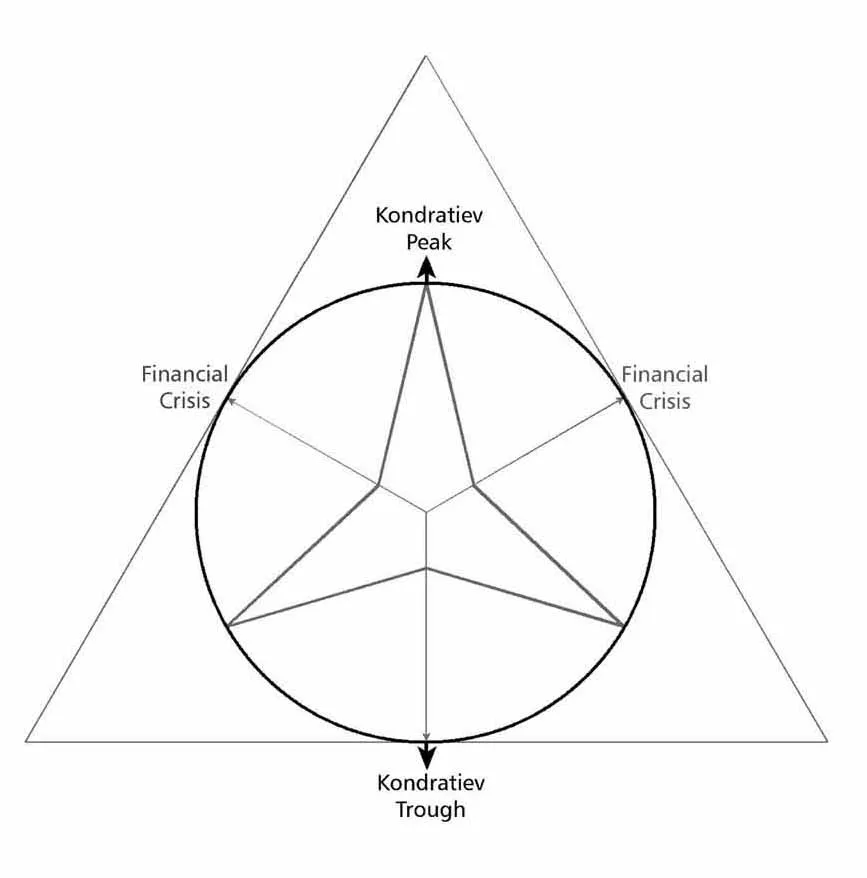![]()
Part I
Radar Views
![]()
Commercial and Economic Geography: Past and Future
Brian J.L. Berry*
it is an honor to have been asked to open this special session on commercial and economic geography at the XXV anniversary celebrations of El Colegio Mexiquense. “What,” I was asked, “have been the principal research foci of the last quarter-century, and where is the discipline likely to go from here?” I thought long and hard about what I might say and I was brought back to the insights of the Spanish-born american poet and philosopher George Santayana, who wrote, “Those who cannot remember the past are condemned to repeat it” (Santayana, 1905: 284). I disagree with him. Even if we remember the past, we are likely to repeat its underlying rhythms. It is characteristic of geography that each new generation of scholars has tried to reinvent the field, but in so doing has repeated enduring themes in an intergenerational dialectic in which the values and orientations of every second generation are more similar than they are to those of adjacent generations. The macrohistorical process is so strong that Santayana’s thought should be supplanted by the first three lines of T.S. Eliot’s Burnt Norton:1
Time present and time past
And both perhaps present in time future
And time future contained in time past
My answer to the question of what the future holds for commercial and economic geography is to recommend that we turn to the past and to what can be learned from the intergenerational dialectic. I can speak from personal experience about the last six decades – roughly half the time since economic geography emerged as a modern university discipline at the beginning of the twentieth century – since I launched my academic career in the late 1950s. To understand the alternating generational themes, we must, however, turn to deeper history.
Two Contesting Themes
A useful place to start is in the early seventeenth century as Dutch navigators reached out from the Low Countries, and amsterdam’s merchants sought information that might be useful in educating their ship captains and adventurers, and extending their trading empires. a young physician from Leiden, Bernhardus Varenius, impressed by the navigators, responded in 1650 by setting down what was known about the Earth and its planetary behavior, latitude and longitude, globe and map construction, and the principles of navigation. his Geographia Generalis2 became the first financially rewarding educational publication, a response to the needs of commerce—a book that (in hindsight) was the first to lay down the basic principles underlying geographic information systems (gis) and the first to serve the practical needs of commercial geography. The work was revised in an edition published by Sir Isaac newton in 1672, and subsequent editions were published and used as late as the early nineteenth century.
Following Varenius, concern emerged about the statistics used to characterize areas, and about how they should be used. a conflict surfaced, which was to shape geographical inquiry in the years that followed. In 1660, a north German philosopher, herman Conring, began to lecture about what he termed “Statistik,” by which he meant the records necessary for the performance of state functions and the categories by which a state should be characterized. Like Thomas Jefferson a century later, Conring held the view that statistics were matters of state (Lindenfeld, 1997). at the same time, in 1662, an Englishman, John Graunt, the acknowledged father of demography, published his Observations on the Bills of Mortality.3 This was the same year in which, another Englishman, William Petty, published his first work in economics, the Treatise of Taxes and Contributions.4 Graunt and Petty believed that social and economic problems should be subject to systematic analysis and that there should be a continuing search for causal relationships among measurable variables. The proper function of statistics was to further such inquiry. There were accompanying ideological differences. Conring advocated a statist ideology, whereas Petty believed in laissez-faire, a central theme in Political Arithmetick,5 a work written around 1676 but published posthumously in 1690.
A bitter debate ensued about the proper nature and value of statistics that by the end of the nineteenth century , during the formative years of modern geography, took on a particular form—a tension between “inventory and description” and “explanation” (Meitzen, 1891). on the descriptive side, textbooks focused on the characteristics of states and regions and on the information needed by future leaders in business and politics. These works culminated in G.G. Chisholm’s Handbook of Commercial Geography,6 an account of world production and trade organized by commodity and country and laid out against a backdrop of climate and geology. But younger geographers were excited by the explanatory schemes of Social Darwinism and developed an explicit geographical version, Environmental Determinism. Their new theory was clearly set down by the first president of the association of american Geographers, William Morris Davis, in his 1906 presidential address: “any statement is of geographic quality if it contains…some relation between an element of inorganic control and one of organic response” (Davis, 1906: 71). To Davis, human society was an organism that survived by adjustment to the physical environment; the nature of its growth thus was environmentally prescribed. “Mere description” was pushed from the new discipline’s mainstream and replaced by an environmentalist idea that was so strong that sociologist Pitirim a. Sorokin (1964), termed it, “The Geographical Theory” With this replacement, the contesting theories of the eighteenth and nineteenth centuries became the generational themes that have alternated in the geography of the twentieth century.
Generational Rhythms in American Social History
At this juncture, we need to take a detour into the sociological theory of cohort generations advanced by William Strauss and neil howe (1991), a theory that helps explain generational alternations. Strauss and howe identified a succession of cohort generations that have dominated american life since settlers first came to north america. a cohort generation consists of everyone born in a particular time-span or “cohort period,” sharing a common age bracket as they move through their life cycles, experiencing the same economic and social conditions and sharing a distinct worldview. Members of a cohort generation, they argue, share a peer relationship that derives from a combination of a common age location with respect to the background chronology of historic trends and events, perceived membership in a group that shares both beliefs and behavior, and a sense of social community that is reinforced by the expectations of elders. Each generation moves through a common sequence of life phases, each occupying a cohort period: youth, young adulthood, mature adulthood, and elderhood, and what develops during these times is the adherence to certain fundamental notions, a generational weltanschauung or web of beliefs, and attitudes about fundamental questions.
Cohort periods are separated by times of stress when people perceive that historical events are radically altering their social environments. During these times of stress each existing cohort defines the central role of the phase of life that it is entering in a direction that reverses the perceived excesses of the cohort occupying the same life phase since the last crisis, producing a dialectic that alternates between adjacent generations and leads to a peer-personality relationship among two-apart generations.
Such a dialectic has characterized geography since its establishment as a modern academic discipline in the late nineteenth and early twentieth centuries, with each cohort period containing three cohort generations—the young adults striving to implement their own image of the field, the mature adults in positions of leadership, and the elders fretting about the leaders’ initiatives and extending a helping hand to the young.
Linkages to the Long Wave
The average length of a Strauss–howe generation is between 18 and 19 years, which is the same periodicity as the 18.6-year Kuznets cycles that are modelocked three to a Kondratiev long wave (Berry et al., 2001). as illustrated in Figure 1, one Kuznets cycle begins in a Kondratiev trough, rises to a peak on the inflationary upwave, and then descends to a Kuznets trough in an economic crisis. The second Kuznets cycle tracks the inflationary spiral to the Kondratiev peak and comes to an end in the ensuing stagflationary collapse. The third of the cycles occupies the deflationary downwave and ends in the next Kondratiev trough. The times of stress that separate cohort periods thus are the times of stress associated with Kuznets troughs, that is, they are significant economic crises. Each Strauss–howe generation, nested between a pair of Kuznets troughs, thus is associated with a particular Kuznets cycle.
Figure 1. Relationship between Kondratiev waves and Kuznets cycles. Kondratiev waves, depicted by the circle, chart the rise of inflation from the trough (exemplified by the current Great Recession) to an upward spiral at the peak (the last occurred in 1980–81) and back down to the next trough, a sequence taking approximately 56 years. Mode-locked within each of these waves are three Kuznets cycles of economic growth and recession, each of some 18.6 years long. Depicted both by the green triangles within the Kondratiev circle and tangential to it, t...

